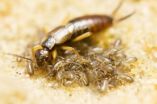(Press-News.org) MADISON – Like rings of a tree, hair can reveal a lot of information about the past.
It can tell if a person recently used drugs or an athlete was doping. It can provide information about hormones and expose environmental toxins.
And, as a team of University of Wisconsin-Madison researchers show in a study of rhesus monkeys, published in the April 2014 edition of the journal Pediatric Research, it can also reveal the womb environment in which an infant formed.
It's the first time researchers have used infant hair to examine the hormonal environment to which the fetus was exposed during development and it promises to yield a wealth of new information. The findings have significant implications for several fields, from neonatology to psychology, social science to neurology.
"We had this 'Aha!' realization that we could use hair in newborns, because it starts growing one to two months before birth," says Christopher Coe, UW-Madison professor of psychology and director of the Harlow Center for Biological Psychology. "It provides a glimpse of the prenatal hormone environment."
Hair closest to the scalp reveals the most recent information but moving down the shaft effectively transits an individual's hormonal timeline.
For the noninvasive study, researchers took small samples of hair from mother rhesus monkeys and their infants using common hair clippers. The hair was cleaned and pulverized into a fine powder using a high-speed grinder. The hormonal signature was then read using a new mass spectrometry method.
The researchers were interested in whether there were differences in the hormones of infants born to younger, first-time mothers versus more experienced mothers. To test their question, they compared monkey mothers equivalent in age to 15-year-old humans to older monkeys, similar in age to pregnant young adults.
"It provided a model of teenage pregnancy," says Coe. "You're still growing yourself and if you're 15 and pregnant, mom and developing baby are more in competition with each other."
The researchers used rhesus monkeys because they are an ideal model species for humans.
It's well known that maternal age plays a role in pregnancy and delivery outcomes, and a growing body of evidence shows that levels of some hormones – such as the stress hormone cortisol and female-typical hormones like estrogen – are higher in young mothers and younger women pregnant for the first time.
Prior studies have shown high levels of cortisol and drugs that act like it can have a lasting impact on the developing brain, including impairment in reflexes and attention, and an increased incidence of emotional and learning problems.
In the monkey study, researchers found that cortisone, an inactive form of cortisol, was higher in young mothers and in their babies than in hair of the older mothers and their infants.
Babies born to young mothers also had higher levels of estrone (a form of estrogen) and testosterone in their hair than did babies born to older mothers. Levels of both these hormones were surprisingly similar between male and female infants.
Both Coe and Amita Kapoor, first author of the study and former postdoctoral researcher in Coe's lab, are particularly interested in whether these differences impact "maleness and femaleness" of the babies: whether higher exposure to these steroid hormones during fetal development leads to more pronounced gender differences in behavior later in life.
The findings raise questions about everything from the significance of birth order to stereotypical "boy" and "girl" behaviors in children.
Additionally, what happens to a developing fetus while in the womb may impact its risk for chronic disease later in life, says Kapoor.
"Type 2 diabetes, metabolic disease, coronary artery disease, psychiatric disorders – there [may be] a whole host of long-term repercussions of stress in utero," says Kapoor, now an assistant researcher at the Wisconsin National Primate Research Center's Assay Services.
She referred to a theory proposed by the epidemiologist David Barker, which suggests the developing fetus may be "programmed" in response to the womb environment.
Those who study people are "really excited because it's so noninvasive," Kapoor says, although getting enough hair from humans is a challenge researchers have nearly, but not quite, figured out. Most human babies aren't as hairy other primates.
For the rhesus study, Kapoor – working with colleague Curtis Hedman, of the Wisconsin State Laboratory of Hygiene – was able to refine a new method for looking at multiple hormones at a time.
She was able to analyze eight hormones simultaneously and is now working to increase that number.
For Coe, this "proof-of-concept" study provides a new world of opportunity.
Because hair is non-toxic and stable at room temperature, it's easy to store and easy to transport.
"How does the prenatal environment set the stage for risk or for resilience?" he asks. "The new collaborations are an unexpected gift. It's more than just cool technology or a cool idea."
INFORMATION:
– Kelly April Tyrrell, 608-262-9772, ktyrrell2@wisc.edu
Hair from infants gives clues about their life in the womb
2014-04-15
ELSE PRESS RELEASES FROM THIS DATE:
Unexpected protein partnership has implications for cancer treatment
2014-04-15
Scientists have identified two unlikely partners, in a type of immune cell called a macrophage, that work together, in response to cancer drugs, to increase inflammation in a way that may alter tumor growth. Researchers from the National Institutes of Health published the study in the journal Cancer Research.
These partners are the p53 protein that suppresses tumors and the nuclear factor-kappaB (NF-kappaB) protein that stimulates their growth. Blocking this partnership could help prevent inflammation from occurring in cancer patients undergoing chemotherapy.
"Since ...
New method of screening children for autism spectrum disorders works at 9 months old
2014-04-15
Washington, DC – Researchers, including a team from Children's National Health System, have identified head circumference and head tilting reflex as two reliable biomarkers in the identification of autism spectrum disorders (ASD) in children that are between 9 and 12 months of age.
According to the U.S. Centers for Disease Control and Prevention, ASD is identifiable as early as two years old, although most children are not identified until after the age of four. While a number of studies have reported that parents of children with ASD notice developmental problems in ...
Low-calorie restaurant menus: Are they making us fat?
2014-04-15
Depending on our food cravings, the number of items served, and even the time of day, ordering a meal at a restaurant often requires a "narrowing down" decision making process. According to a new study in the Journal of Consumer Research, restaurants that now provide "low-calorie" labels on their menus can inadvertently cause people to eliminate healthy foods right off the bat.
"Because most restaurant menus are quite complex—offering numerous dishes composed of multiple ingredients—diners try to simplify their decision. People have come to expect low-calorie food to ...
More should be done for female parolees
2014-04-15
EAST LANSING, Mich. --- As the female prison population grows, a new study funded partly by the National Science Foundation says more should be done to help women probationers and parolees in poor urban areas remain crime-free.
A team of Michigan State University criminologists found black women on probation and parole feel they have little choice but to isolate themselves in their homes or risk getting caught up in the type of criminal activity that got them in trouble in the first place.
Probation and parole officers, case managers and others should help the women ...
When identity marketing backfires: Consumers don't like to be told what they like
2014-04-15
When choosy moms choose Jif peanut butter and sports fans who call themselves sports fans subscribe to DirecTV, identity marketing is hard at work. But what happens when this type of advertising misses the mark? According to a new study in the Journal of Consumer Research, when a person's sense of ownership and freedom is threatened they are less likely to respond positively to identity marketing campaigns.
"While people may be drawn to brands that fit their identity, they are also more likely to desire a sense of ownership and freedom in how they express that identity. ...
Sibling cooperation in earwig families gives clues to early evolution of social behavior
2014-04-15
Looking at the question of how social behavior has developed over the course of evolution, scientists from the universities in Mainz and Basel have gained new insights from the study of earwigs. "Young earwig offspring don't simply compete for food. Rather the siblings share what is available amongst themselves, especially when the mother is absent," explained Dr. Joël Meunier of the Evolutionary Biology section of the Institute of Zoology at Johannes Gutenberg University of Mainz (JGU). The team of biologists from Mainz University and the University of Basel investigated ...
Charitable donation discrepancies: Why are some countries more generous than others?
2014-04-15
When it comes to charitable giving, some countries open their collective wallets more than others. According to a new study in the Journal of Consumer Research, people who live in countries that promote equality in power and wealth are more likely to donate money than those who live in societies that expect and accept inequality.
"Our research examines whether cultural values can explain the different levels of charitable giving between different countries," write authors Karen Page Winterich (Pennsylvania State University) and Yinlong Zhang (University of Texas, San ...
Chew on this: How does food texture impact its perceived calorie content?
2014-04-15
Food is an intimately personal thing; we savor some tastes and despise others. But how does the way we chew and eat our food impact our overall consumption? According to a new study in the Journal of Consumer Research, people perceive foods that are either hard or have a rough texture to have fewer calories.
"We studied the link between how a food feels in your mouth and the amount we eat, the types of food we choose, and how many calories we think we are consuming," write authors Dipayan Biswas, Courtney Szocs (both University of South Florida), Aradhna Krishna (University ...
Consumer predictions: Do categories matter when predicting the lottery or stock market?
2014-04-15
From sports to the stock market and even winning the lottery, it's in our nature to predict who or what will come out on top. But, sometimes we can't see the forest for the trees. According to a new study in the Journal of Consumer Research, people are more likely to make a prediction about something when it is grouped in a large category of similar items.
"One factor that can contribute to a person's flawed judgment is categorization," write authors Mathew S. Isaac (Seattle University) and Aaron R. Brough (Utah State University). "When making a prediction, we can become ...
Can refined categorization improve prediction of patient survival in RECIST 1.1
2014-04-15
In a recent analysis by the RECIST Working Group published in the European Journal of Cancer, EORTC researchers had explored whether a more refined categorization of tumor response or various aspects of progression could improve prediction of overall survival in the RECIST database. They found that modeling target lesion tumor growth did not improve the prediction of overall survival above and beyond that of the other components of progression. The RECIST Working Group includes the EORTC, the United States National Cancer Institute, and the National Cancer Institute of ...

